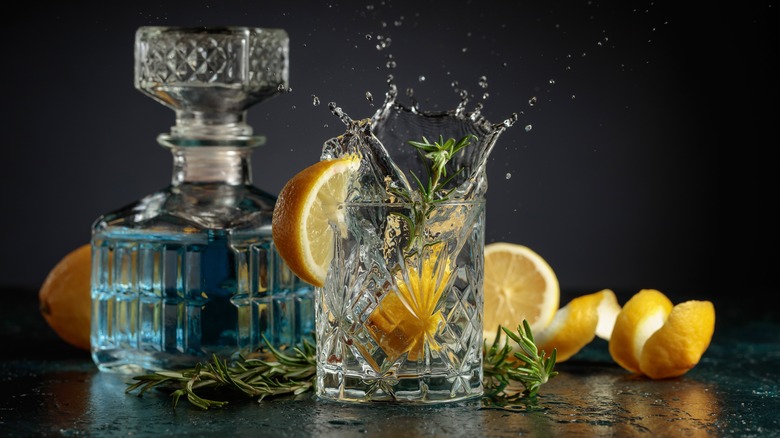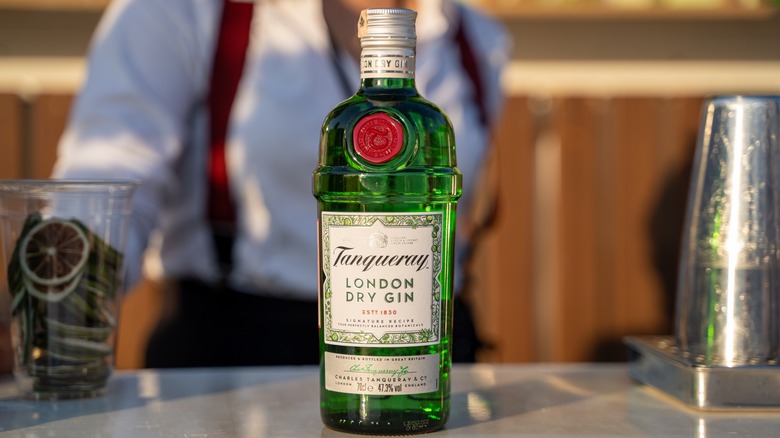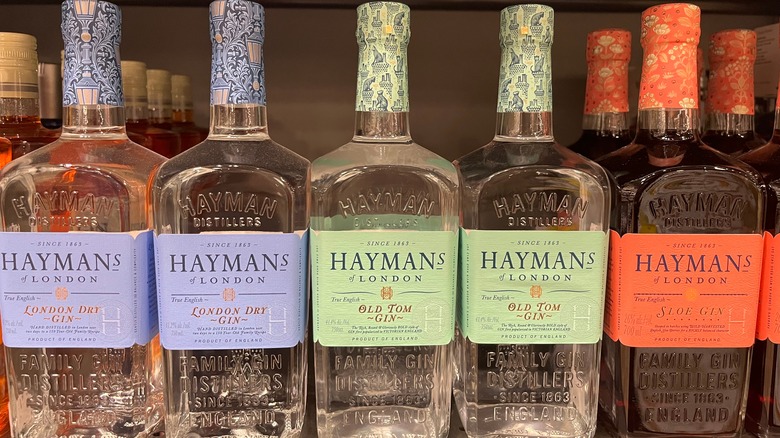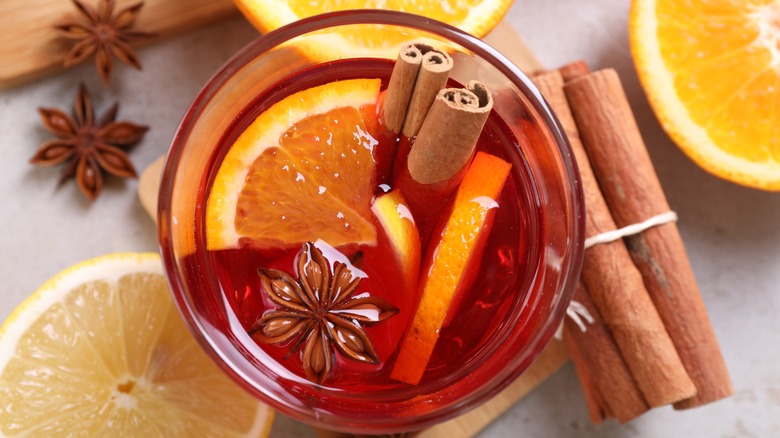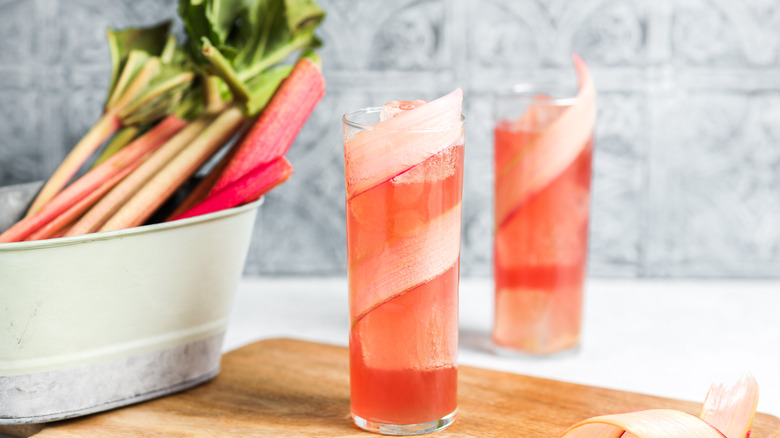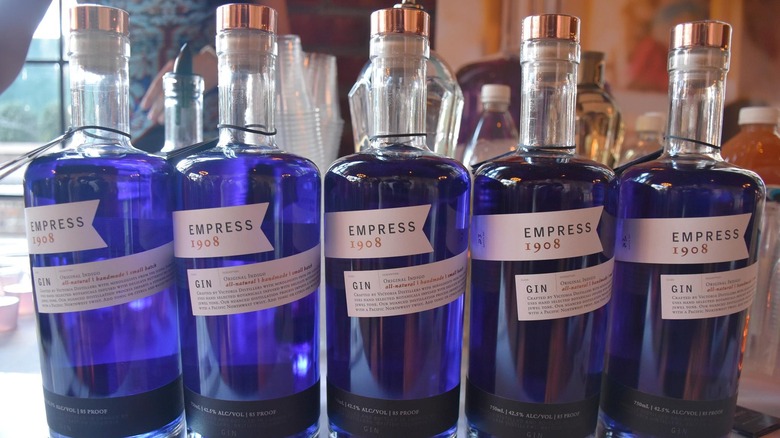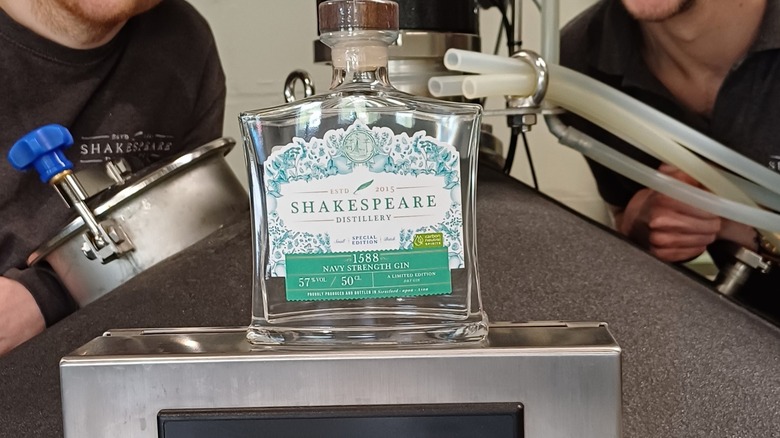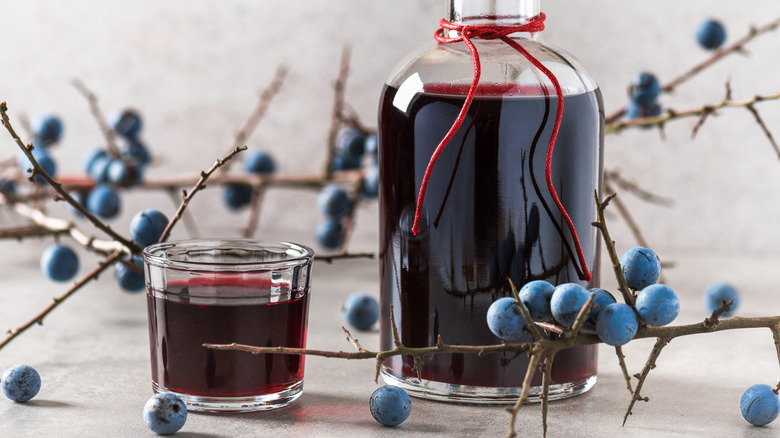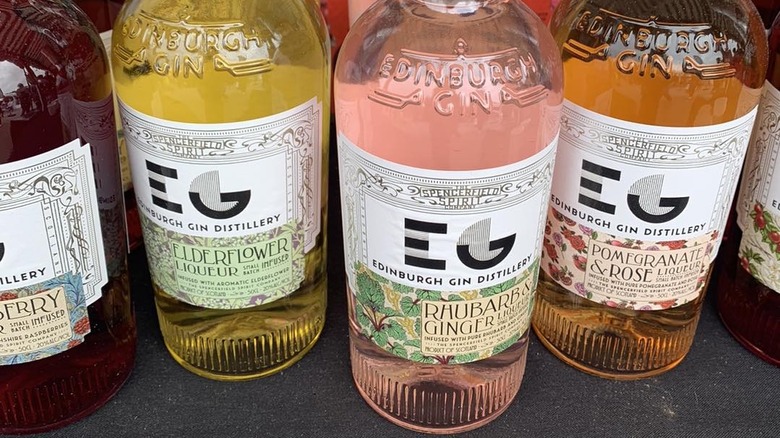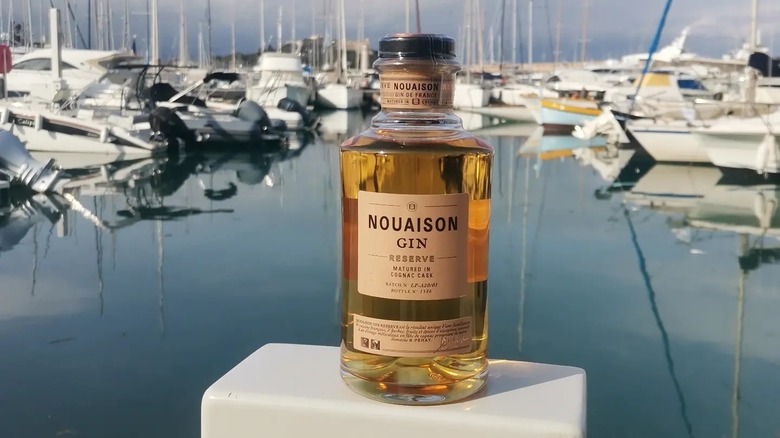9 Types Of Gin And How To Sip Them, According To An Expert
We may receive a commission on purchases made from links.
Despite its bold, distinctive flavor, gin is one of the most versatile spirits you can find behind a bar. A perfectly iced gin and tonic is the ultimate refresher on a hot day, while classic gin cocktails, like martinis and negronis, are famous mixology staples. Primarily flavored with juniper berries, gin is a botanically infused grain (like barley or wheat) spirit with a minimum ABV of 37.5 or more.
Modern gin-making has expanded massively in recent years, and customers can now find a whole host of flavored gins, sloe gins, and spiced gins on liquor store shelves. Many artisanal gin producers also use regional botanicals and herbs to create gins with a local terroir — a flavor that reflects their native environment.
To help unravel the complexities of this iconic spirit, we spoke to Sarah Miller — a gin expert and freelance drinks writer at Gin A Ding Ding. Miller talked us through some of her favorite gins and how to make the most of their unique flavor combinations. So, try one of these expert-recommended pours next time you're stuck for tipple ideas.
1. Classic gins
Classic gins have a clean, sharp flavor that most people associate with a standard gin and tonic. With their prominent juniper notes, classic gins, like Beefeater, Tanqueray, and Sipsmith, fall under the London dry gins category. This type of gin was invented in London during the 19th century by local distillers who wanted to tackle the sale of poor quality, or even lethal, homemade gins. London dry gins can be produced anywhere but must not contain additives or more than 0.1 grams of sweetener.
Sarah Miller observes that classic gins' crisp, piney taste means that they "work in almost any cocktail," although "you can't go wrong with a martini or Indian tonic water." Gin martinis — gin, vermouth, and garnish — can be served wet or dry, with a wet gin martini containing more vermouth than a dry one. Usually, the major difference between shaking cocktails wet and dry is whether you use ice but in martinis it refers to the vermouth ratios.
Miller notes that loading up on ice is the key to a classic gin and tonic. Icing your G&T cuts through the gin's strong flavor, and using a cold glass will stop the ice from melting too fast and diluting your drink. You can also use sour fruit garnishes to cut gin's bitter notes. "Don't limit yourself to a slice of lemon," Miller advises — "try experimenting with lime, orange, or even pink grapefruit."
2. Old Tom gins
Unlike traditional classic gins, which have bitter notes, Sarah Miller explains that "Old Tom gins were popular in the 18th century and are usually a little sweeter than classic dry gins." Originally, Old Tom gins were infused with licorice, aniseed, lemon juice, or sugar to disguise impurities in the distillation process. This gave the gin a syrupy consistency that was very different from London dry gins, which overtook Old Tom in popularity during the late 1800s and has dominated the market up to the present day. As many people, especially in the U.K., made gin at home during the 18th and 19th centuries, the exact recipe for Old Tom gin featured a great deal of variation.
Some modern gin-makers have reclaimed the spirit by creating their own Old Tom-style recipes. Gin brands, such as Hayman's and Warner's, sell Old Tom gins infused with various botanicals, including coriander, angelica, elderflower, and licorice, to give the spirit a smooth and herbaceous flavor. These gins are usually sweetened with honey or sugar syrup. When it comes to serving suggestions for Old Tom gin, Miller recommends adding it "a Tom Collins cocktail" made with "lemon juice, soda, and sugar syrup for a long, refreshing serve."
3. Spiced gins
According to Sarah Miller, spiced gins "tend to be heavier on" aromatic spices, such as "cardamom, cinnamon, ginger or nutmeg." Many gin companies roll out their spiced gin brands around the holidays, as these warm, earthy flavors are associated with cozy, winter treats. Asian spiced gins are also popular and often contain notes of star anise, lemongrass, and Kaffir lime. You'll also find spiced gins with a nutty or woody flavor profile from added licorice and barks, like frankincense and cassia.
Unlike other botanical liquors, like amaro or fernet, spiced gins are rarely consumed neat as aperitifs or digestivos. Instead, the herbal notes in spiced gins are designed to complement and balance other flavors, meaning they work well in mixed drinks.
Miller states that spiced gins are tasty "in a classic negroni served in a rocks glass over a large ice cube." To pour one at home, you'll need the spiced gin of your choice, along with Campari, vermouth, and an orange peel twist for garnishing.
Bitters can make or break your homemade cocktail, so throw in a splash of Angostura to complete your drink. Some producers even specialize in chili-infused gins that give a fiery kick to a classic G&T.
4. Pink gins
Pink gins are flavored gins that have become well-known for their rosy, vibrant shade. It's easy to see why bartenders love pink gins — they look great in spritzer cocktails garnished with summer berries. Sarah Miller explains that pink gins "tend to be sweetened, colored, and flavored with raspberry or strawberry." Rhubarb pink gin is also popular — Miller suggests that a pink gin should be "served with ginger ale or Mediterranean tonic and a slice of orange."
Producers will often add pressed red fruit juice to the spirit to make pink gin after it has been distilled with botanicals. Fragrant botanicals, like rose petals, jasmine, and hibiscus, are common in pink gins and contribute to their sweet, floral palette. Pink gins colored with natural fruit juices will lose their pink tinge over time, especially if the bottle is left standing in direct sunlight.
Serve pink gin with lemon-flavored soda, ice, and a lemon garnish as a refreshing garden party spritzer. You can also turn clear London dry into a pink gin cocktail by mixing it with pink soda. If you've ever wondered what, exactly, is the pink in pink lemonade, many artisanal brands use red fruit juice, just like pink gin producers. Garnish with raspberries and fresh mint, and enjoy.
5. Color-changing gins
Color-changing gins are some of the most fun spirits on the market. Their shifting shades can turn a simple cocktail into a dazzling experience, making them popular with mixologists and bartenders. According to Sarah Miller, color-changing gins "use butterfly pea flower (Clitoria Ternatea) to give their spirits a deep blue/purple color." This violet liquor "transforms to a pretty pink shade with the addition of an acidic mixer such as tonic water."
Inspired by this natural special effect, gin makers around the world experiment with color-changing gins in a wide range of hues and flavors. Miller recommends Pink Marmalade, made with a zesty blend of 13 botanicals – including pink peppercorn and salted grapefruit. Other popular brands include the bright blue Empress 1908 and The Secret Garden's Lavender & Echinacea Gin, which has a smokey, floral taste and contains antioxidants from the echinacea extracts. Color-changing gin transforms a classic cocktail, like a gin and prosecco French 75, into a delicate indigo delight.
6. Navy strength gins
When it comes to boozy spirits, navy strength gins pack a serious punch and have a rich seafaring history. These gins are 57% ABV or above and are usually clear, dry spirits. The term navy strength is believed to have officially originated in 1997 when Plymouth Gin launched its Plymouth Navy Strength brand — a reference to the British Navy's long tradition of carrying and serving gin on board its ships.
British navy ships in the 18th and 19th centuries would stock up on gin from ports like Plymouth before setting off to sea. The gin needed to be strong so that, if it leaked onto the stored ammunition below deck, the gunpowder would still ignite and remain usable.
When asked to recommend a navy strength gin, Sarah Miller explains that if you're looking for an "authentic serve," that recalls gin's deep navel roots, "a navy strength gin in a gimlet with Rose's Lime Cordial," is perfect. This drink "originated on British naval ships during the 19th century after it was discovered that consuming citrus juices would prevent scurvy" during long sea voyages.
7. Sloe gins
While traditional gins are classified as spirits, Sarah Miller clarifies that sloe gins are "technically liqueurs." Sloe gins are "flavored with the fruit of the blackthorn tree, are usually sweetened, and tend to come in at a lower ABV" than straight gins. Sloe gins are very similar to other types of liqueur in that the addition of sugar and fruit essentially dilutes the gin-proof. Liqueurs are often confused with fortified wines, such as brandy and cognac – cognac and brandy are actually different drinks because cognac has protected status and can only be made in specific regions – but fortified wines are stronger due to the added spirits.
You can make your own sloe gin at home by steeping ripe sloe berries — a dark, musty purple that look like plums — in dry gin with sugar for around three months. As with pink gins, you'll want to store your sloe gin in a dark space so that the sunlight doesn't interfere with the natural ruby color that sloe gin should develop.
For creative sloe gin cocktail ideas, Miller suggests switching up your negroni with a "sloegroni" or pouring sloe gin over ice and lemon tonic water. You could also experiment with classic sloe gin mixers, like a red rum martini – sloe gin, rum, lemon juice, and vanilla syrup — or a brandy, lime, and sugar Charlie Chaplin.
8. Floral gins
Like pink gins and spiced gins, floral gins are spirits infused with traditional juniper berries and various complementary botanicals. However, while spiced gins focus on aromatic seasonings and pink gins are usually made with red fruits, floral gins are concocted using flowers, herbs, and other local plant life. Popular flower infusions include jasmine, hibiscus flower gins, and gin made with rose petals. You'll also find floral gins that combine botanicals such as lovage, cherry blossoms, lavender, chamomile, ylang-ylang, and borage.
According to Sarah Miller, "floral gins are often lighter, delicate, and more perfumed than other gins," as the fragrant botanical notes are allowed to take center stage. Floral gins can be enjoyed with a flavored tonic or served in a fresh, summer cocktail. Miller suggests a "bee knees," made with honey syrup and fresh lemon juice. Shake this cocktail in a mixer with ice, or add the ingredients to your blender — a kitchen appliance that takes cocktails to a whole other level – and give them a quick blitz before serving.
9. Matured gins
Like other aged spirits, matured gins are gins that have been left to rest for a period of time. Sarah Miller explains that matured gins are usually aged in wood casks as this deepens the spirit's color and flavor. "Bridging a gap between white and dark spirits," Miller observes, matured gins "can be sipped neat but also work well in a gin old-fashioned" — a cocktail made with gin, sugar syrup, and bitters. If you're confused about different cocktail glasses and what they should be used for, you can serve your gin old-fashioned in a lowball or rocks tumbler, traditionally used for a whisky old-fashioned.
Miller also notes that, like with whisky and wine, the type of wood chosen to age the gin significantly impacts the final flavor. She draws attention to the creative ways that many modern gin producers use wood aging to improve the gin's flavors and add unique terroir elements. "One of my favorites," she explains, "is India's Broken Bat Gin created by aging Greater Than London Dry Gin with toasted Kashmir Willow from crowd-sourced cricket bats and off-cuts obtained from a bat-maker in Kashmir." This method cleverly blends the spirit maturing process with a touch of local culture and history.
